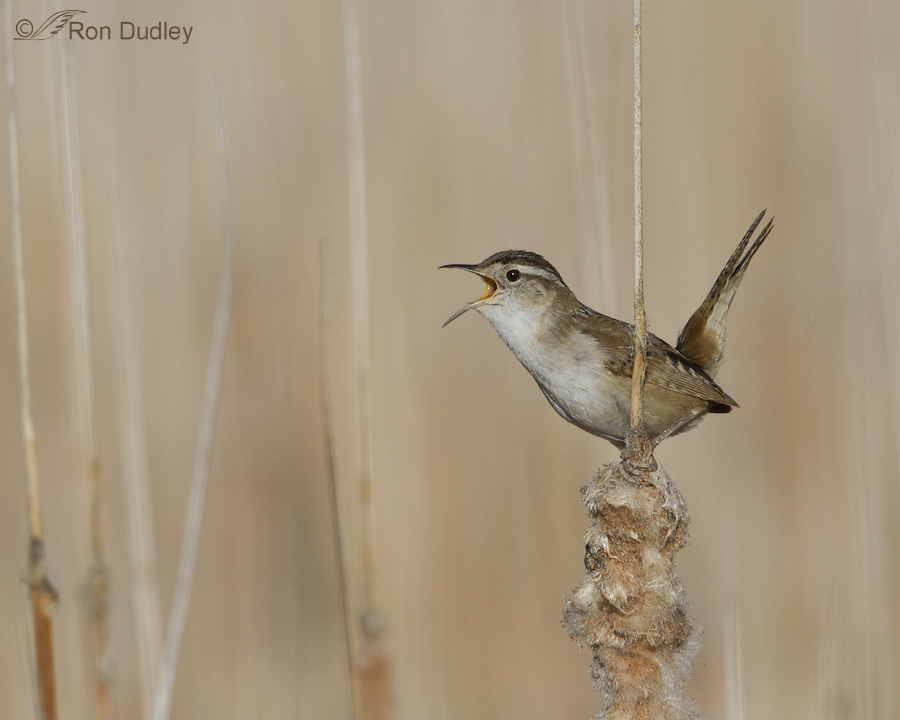Tag: marsh wren
Juvenile Marsh Wren
I normally have difficulty getting close enough to Marsh Wrens for them to be large enough in the frame to show good detail. They’re very small, incredibly flitty and they inhabit busy backgrounds – all challenges for the photographer. Last year I had some success with adults but juveniles have always eluded me. 1/1600, f/6.3, ISO 500, 500 f/4, 1.4 tc But yesterday at Bear River Migratory Bird Refuge I found this cooperative juvenile in good light and the background reeds were far enough away from the bird to soften nicely. And I didn’t even get shadows from the reeds falling on the bird which is unusual for me. I love these feisty, raucous little birds and they have unbelievable energy. They scurry from perch to perch and sing almost continually, day and night during breeding season, in their bid for reproductive success. It makes me tired just to contemplate such a frenzied existence. Think I’ll take a nap… Ron
“Baiting” – A Matter of Definition and Ethics
Baiting just may be the most hotly debated topic in the bird photography community. Part of that debate revolves around the fact that not all nature photographers agree on a precise definition for the term. I’ve followed and participated in discussions of this “hot topic” in nature photography discussion forums for years now and it seems that the most mainstream definition, the one that the vast majority of avian photographers subscribe to, is a version of this: baiting – using food or other items or methods to artificially lure birds in close to the photograpaher. This would include using recorded bird calls, “setups”, back yard bird feeders, stuffed raptors (many birds come in to “mob” raptors) and a variety of other ingenious methods used by some well known “nature” photographers. One of the most controversial forms of baiting is using live bait (often pet store mice) to bring in raptors – owls in particular. This practice can have many negative efffects on the birds – from making them dependent on an artifical food source to spreading disease to causing birds to be hit by cars – not to mention the ethical dilemma of “nature” photographers photographing birds in unnatural situations. To bait or not to bait is an ethical decision that virtually every bird photographer must make. For me that decision was easy – I do not bait my intended subjects. I do sometimes photograph birds at my back yard feeder simply for the practice but I don’t post those images on online forums, include them on my website…
Marsh Wrens of Bear River Migratory Bird Refuge
This week I was finally able to get some decent images of Marsh Wrens. Canon 7D, 1/2000, f/8, ISO 400, 500 f/4, 1.4 tc In the past these birds have always been buried too deeply in vegetation for me to get shots I liked but a couple of days ago they finally cooperated with me. Canon 7D, 1/1600, f/8, ISO 400, 500 f/4, 1.4 tc Marsh Wrens have incredibly interesting behaviors. For example, western males must learn up to 200 different songs (eastern birds only learn about 50). Perhaps that’s why these males sing so much – it would take a lot of practice to learn that many “tunes”. Canon 7D, 1/1600, f/8, ISO 400, 500 f/4, 1.4 tc These birds are extremely territorial and aggressive. They are polygynous (males mate with multiple females) and in order to attract females the male builds from 6 to 22 “dummy” nests for every one that is actually used to raise a brood of chicks. We could see several of these nests buried in the cattails along the refuge road. Canon 7D, 1/2500, f/7.1, ISO 400, 500 f/4, 1.4 tc According to the Bear River Blog many of these nests were destroyed by our recent stormy weather and heavy rains so many of these males have had to start over. Canon 7D, 1/2000, f/8, ISO 400, 500 f/4, 1.4 tc Marsh Wrens of both sexes regularly destroy eggs and chicks of other birds near their territories, including those of…


